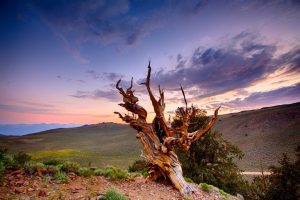22 December 2016
Iconic bristlecone pines may not survive global climate change
Posted by Lauren Lipuma

Bristlecone pines, like Methuselah, might lose habitat as temperatures warm, new research finds.
Credit: Chao Yen (CC BY-ND 2.0, Flickr)
By Ula Chrobak
Bristlecone pines—including Methusaleh, one of the world’s oldest trees—have lived in North America’s Great Basin for thousands of years. But warming temperatures due to climate change could cause trouble for the ancient trees by tipping the ecological balance in favor of the conifer’s neighbor, the limber pine, said scientists at the 2016 American Geophysical Union Fall Meeting.
Both limber and bristlecone pines are adapted to the temperature and moisture of subalpine forests. As the species’ favorite temperatures move up mountains due to climate change, logic says the trees should follow them upward. But a new study finds limber pines are leap-frogging over bristlecones: most of all the juvenile trees above the historic treeline are limber pines.
“The [trees] aren’t just moving in lock step.” said Brian Smithers, an ecologist at the University of California Davis and lead author of the new study. “Species are moving around the landscape in unpredictable ways.”
As limber pines pile up above the historic treeline, it’s possible they will use up so much light and water that it becomes impossible for bristlecone pines to join them, according to the researchers. This could mean the end of ancient trees like 4,848-year-old Methuselah. While still uncertain whether the limber pine will completely win out over bristlecones, Smithers thinks we may see the loss of this iconic tree.
“I think what’s going to happen—at least in some areas—is that we’re going to lose bristlecone,” he said. “There’s not very much room upslope before you get to the top of the mountain.”
Below the treeline—the altitude above which it’s too cold for trees to grow—bristlecone is king. The tree dominates the subalpine community, growing in all spaces except in sandy, granitic soils, where limber pines huddle together.
As temperatures have steadily warmed with climate change, the vertical limit where these trees can survive has creeped uphill. So scientists set out to see whether both of the trees also hiked up.
First, they estimated the historic treeline, based on where adult trees, above three meters (10 feet) tall, clumped together. Above this line, they counted juvenile trees that had hopped over, identifying them and estimating their age based on scars on their stems. They compared the community of young trees above the line to adult trees below the line to see how the species distribution changed.
“What we were finding is that limber pine is taking over the status of the treeline tree,” Smithers said. Above the treeline, young limber pines dominated, even encroaching on limestone and dolomite-based soils—normally the territory of bristlecones. The limber pines are faster than bristlecones at spreading, thanks to the help of the Clark’s nutcracker, a bird that eats and disperses their seeds, Smithers said.
“Whoever can get there first wins,” Smithers said. “And it looks like limber pine is just better able to get there quicker.”
Next, Smithers will use experimental plots around the White Mountains in California and Nevada to look at how limber pines compete for water and light. This simple system could help illustrate how a change in temperature can trigger complex interactions between species, he said.
—Ula Chrobak is a science communication graduate student at UC Santa Cruz.


 GeoSpace is a blog on Earth and space science, managed by AGU’s Public Information staff. The blog features posts by AGU writers and guest contributors on all sorts of relevant science topics, but with a focus on new research and geo and space sciences-related stories that are currently in the news.
GeoSpace is a blog on Earth and space science, managed by AGU’s Public Information staff. The blog features posts by AGU writers and guest contributors on all sorts of relevant science topics, but with a focus on new research and geo and space sciences-related stories that are currently in the news.